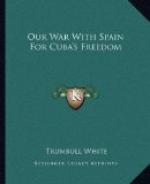The Spanish commander sent his chief of staff, Captain Oviedo, under a flag of truce to Admiral Sampson, bearing the information of the safety of the heroes. The Spanish officers were enthusiastic in their praise of the bravery shown by Hobson and his men, and looked upon them with amazement as heroes whose gallantry far exceeded any Spanish conception of what men might do for their country, and it was with great chagrin that Admiral Cervera was prevented by the Madrid authorities from returning the heroic young officer and his brave men to Admiral Sampson, but was compelled to deliver them to the military authorities ashore as prisoners of war.
Thrown into A dungeon by Linares.
General Linares, with the brutal instinct that had marked his conduct of Cuban affairs already intrusted to him, deliberately placed Hobson and his men in Morro Castle as a shield against the fire of Sampson’s squadron. Here Hobson was locked up for five days in solitary confinement in a filthy dungeon under conditions which must have soon resulted in his serious illness and perhaps in death. The treatment he received and the scanty food given him were no better than that accorded to a common criminal condemned to execution.
This punishment, however, was of short duration on account of the vigorous protest which was made through a neutral power to Spain, coupled with Admiral Sampson’s notice to the Spanish admiral that he would be held personally responsible for Hobson’s welfare. Under these circumstances Admiral Cervera interposed his influence with General Linares; and Hobson, with his men, was transferred to the barracks in the city. Here his solitary confinement continued, but he could look out of a window to the hills on the east and see the smoke from the American rifles of General Shatter’s men firing from their intrenchments with the consolation that his captivity would be of short duration.
After the assault on Santiago arrangements were made by the commanders of the two armies for the exchange of Lieutenant Hobson and his men for Spanish prisoners held by the Americans, and a truce was established for that purpose. The place selected for the exchange was under a tree between the American and Spanish lines, two-thirds of a mile beyond the intrenchments occupied by Colonel Wood’s Bough Eiders, near General Wheeler’s headquarters, and in the center of the American line.
The American prisoners left the Keina Mercedes hospital on the outskirts of Santiago de Cuba, where they had been confined, in charge of Major Irles, a Spanish staff officer, who speaks English perfectly.
The prisoners were conducted to the meeting place on foot, but were not blindfolded. Colonel John Jacob Astor and Lieutenant Miloy, accompanied by Interpreter Maestro, were in charge of the Spanish prisoners. These consisted of Lieutenants Amelio Volez and Aurelius, a German, who were captured at El Caney, and Lieutenant Adolfo Aries and fourteen non-commissioned officers and privates. Lieutenant Aries and a number of the men were wounded in the fight at El Caney. The Spanish prisoners were taken through the American lines mounted and blindfolded.




